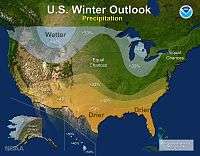2016–17 North American winter
| Astronomical winter | December 21 – March 20 |
|---|---|
| Meteorological winter | December 1 – February 28 |
The 2016–17 North American winter refers to winter in North America as it will occur across the North American continent from late 2016 through early 2017. While there is no well-agreed-upon date used to indicate the start of winter in the Northern Hemisphere, there are two definitions of winter which may be used. Based on the astronomical definition, winter begins at the winter solstice, which in 2016 will occur on December 21, and ends at the March equinox, which in 2017 will occur on March 20.[1] Based on the meteorological definition, the first day of winter is December 1 and the last day February 28.[2] Both definitions involve a period of approximately three months, with some variability.
Seasonal forecasts


On October 20, 2016, the National Oceanic and Atmospheric Administration's Climate Prediction Center issued its U.S. Winter Outlook. A La Niña was expected to influence winter conditions, and the CPC noted that such conditions were likely to either develop in the late fall or early winter. Forecasters also noted that the La Niña, should it develop, would likely be weak and would probably be short-lived. The outlook indicated that above-average precipitation was favored in the northern Rocky Mountains, Hawaii, western Alaska, and in the vicinity of the Great Lakes. The converse was favored across the entire Southern U.S. and southern Alaska. The outlook favored above-average temperatures across the Southern United States extending through the central Rockies, in northern New England, in northern and western Alaska, and especially in Hawaii. Other regions were given "equal chances" of either above or below-average temperatures. Drought conditions were considered likely to continue in multiple regions already in drought, including parts of California and the Southwest. Such conditions were expected to not only remain but also expand in the Southeastern U.S., and development was anticipated in the southern Plains. Lessening of drought conditions was expected in northern California, western New England, parts of the Ohio Valley, the northern Plains, and the northern Rockies, while the expansion of drought conditions was considered likely in eastern New England.[3]
Events
Mid-November winter storm
In the middle part of November, a winter storm affected parts of the northern United States; it brought heavy snow to northern Minnesota and caused over 20,000 buildings to lose power in the state. Wind gusts of up to 70 mph were reported from Minnesota to Michigan.[4]
References
- ↑ "Earth's Seasons: Equinoxes, Solstices, Perihelion, and Aphelion, 2000-2025" (PHP). Washington, D.C.: United States Naval Observatory. September 21, 2015. Archived from the original on August 15, 2015. Retrieved October 14, 2016.
- ↑ "Meteorological vs. Astronomical Seasons". NOAA National Centers for Environmental Information. June 21, 2013. Retrieved October 14, 2016.
- ↑ "U.S. Winter Outlook predicts warmer, drier South and cooler, wetter North: Drought expected to persist in California and expand in the Southeast". National Oceanic and Atmospheric Administration. October 20, 2016. Retrieved October 20, 2016.
- ↑ Winsor, Morgan (November 19, 2016). "First Major Winter Storm of the Season Pummels Midwest and Great Lakes Region". ABC News. Retrieved November 28, 2016.
![]() This article incorporates public domain material from websites or documents of the National Weather Service.
This article incorporates public domain material from websites or documents of the National Weather Service.
External links
| Preceded by 2015–16 |
North American winters 2016–17 |
Succeeded by 2017–18 |